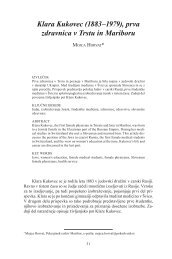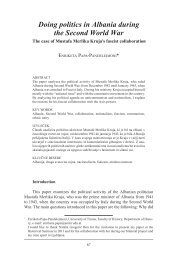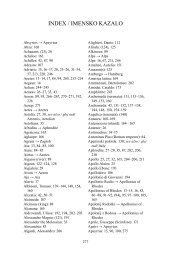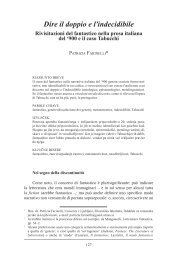The Habsburg Most Illustrious Order of the Golden Fleece: Its ...
The Habsburg Most Illustrious Order of the Golden Fleece: Its ...
The Habsburg Most Illustrious Order of the Golden Fleece: Its ...
You also want an ePaper? Increase the reach of your titles
YUMPU automatically turns print PDFs into web optimized ePapers that Google loves.
<strong>The</strong> <strong>Habsburg</strong> <strong>Most</strong> <strong>Illustrious</strong> <strong>Order</strong> <strong>of</strong> <strong>the</strong> <strong>Golden</strong> <strong>Fleece</strong> ...<br />
To be certain, <strong>the</strong>y all at least meet <strong>the</strong> criteria that regulate Knight nominations<br />
and appointments. In Article 1 <strong>of</strong> <strong>the</strong> Statutes, Philippe <strong>the</strong> Good<br />
stipulated that <strong>the</strong> Knights were all to be “gentlemen <strong>of</strong> name and arms”<br />
without “reproach”. 27 Today, <strong>the</strong> Knights do continue to be individuals at least<br />
“<strong>of</strong> name and arms”, whose genealogies are well documented. <strong>The</strong>y are in<br />
fact members <strong>of</strong> Europe’s elite social classes, specifically and exclusively<br />
royalty and nobility, and some <strong>of</strong> <strong>the</strong>m are likely already well known because<br />
<strong>of</strong> <strong>the</strong>ir non-<strong>Order</strong> related high pr<strong>of</strong>iles: Dr. Otto von <strong>Habsburg</strong>, King Albert<br />
II <strong>of</strong> <strong>the</strong> Belgians, Grand Dukes Jean and Henri <strong>of</strong> Luxemburg, and Prince<br />
Hans-Adam II <strong>of</strong> Liechtenstein, to name just a few. But aside from <strong>the</strong>ir<br />
hereditary statuses, do <strong>the</strong>y continue to represent <strong>the</strong> ideals <strong>of</strong> <strong>the</strong> <strong>Order</strong>?<br />
After all, <strong>the</strong>y do wear <strong>the</strong> insignia <strong>of</strong> <strong>the</strong> <strong>Order</strong>; depending on <strong>the</strong> function,<br />
<strong>the</strong>y ei<strong>the</strong>r wear <strong>the</strong> miniature (Plate 2), <strong>the</strong> <strong>Fleece</strong> neck decoration (Plate 3),<br />
or <strong>the</strong> chain (Plate 4).<br />
Plate 2: <strong>the</strong> miniature <strong>of</strong> <strong>the</strong> <strong>Order</strong> <strong>of</strong> <strong>the</strong> <strong>Golden</strong> <strong>Fleece</strong> (on <strong>the</strong> lapels)<br />
This brings in ano<strong>the</strong>r very important question. When <strong>the</strong> Knights wear<br />
<strong>the</strong> decorations, do <strong>the</strong>y consciously represent <strong>the</strong> ideals <strong>of</strong> <strong>the</strong> <strong>Order</strong>, <strong>the</strong>reby<br />
fulfilling <strong>the</strong> ancient objective <strong>of</strong> <strong>the</strong> <strong>Order</strong> – for those present to have at<br />
least a heightened sense <strong>of</strong> chivalric duty – or are <strong>the</strong>y wearing <strong>the</strong> insignia<br />
for o<strong>the</strong>r reasons such as for labeling <strong>the</strong>mselves as elites <strong>of</strong> some kind?<br />
27 Boulton, <strong>The</strong> Knights <strong>of</strong> <strong>the</strong> Crown, p. 374.<br />
49











